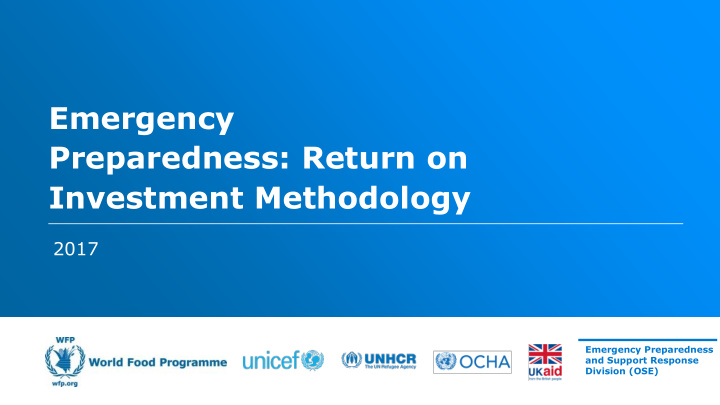



Emergency Preparedness: Return on Investment Methodology 2017 Emergency Preparedness and Support Response Division (OSE)
Return-On-Investment study Part of the Ready-to-Respond Objective: project (DFID): humanitarian Build the evidence base for preparedness in high risk impact of humanitarian countries preparedness work The ROI Methodology is a Phase I: UNICEF+WFP together toolkit to capture returns on with BCG investment of emergency Phase II: OCHA+UNHCR added, preparedness. together with PwC PwC PwC 2
High-level logic: Goals and Users What is this methodology for? developing business cases ( proposals ) for emergency preparedness investments (can be used by all actors) developing advocacy material for initiatives in emergency preparedness assessing and managing emergency preparedness activities analysing existing or past emergency preparedness activities to identify trends or high ROI investments PwC PwC 3
High-level logic: Risks and Time Horizons Users of the ROI methodology must have a clear idea of: Risks Time horizons which emergency scenarios an investment is the period of time over which an designed for investment is being assessed each emergency scenario’s probability, magnitude, etc. the sources of each risk profile (include the source of risk data – e.g. based on historical data or not, etc.) the assumptions that are needed to build each scenario PwC PwC 4
Type of analysis The ROI = difference between results in the without scenario and in the with scenario. 1. Time savings – changes in the time between an emergency being declared and the start of response efforts 2. Contribution to response – a variety of metrics for differences in contribution to the quality of humanitarian response efforts 3. Financial savings – metrics for financial savings achieved as a result of making the investment 4. Greenhouse Gas (GHG) savings – changes in GHG emissions attributable to the investment 5. Indirect effects – any spill over effects attributable to the investment PwC PwC 5
Investment categories 1. FI/NFI prepositioning 2. Infrastructure prepositioning 3. LTA/PCAs 4. Coordination/processes ( new ) 5. Data systems ( new ) 6. Skills/training PwC PwC 6
Tools: for qualitative indicators The methodology includes 3, organization-agnostic, MS Excel questionnaires for assessing: Capacity Strengthening Skills Coordination Questions help determine Training investments are Questions help determine where an institution can assessed in terms of where inter and intra-agency improve its capacity to improvements in: coordination can improve in understand, prepare for , terms of: organisational culture and manage emergencies. partner relationships coordination management skills deployment operational management tangible outputs (such as a decision-making more effective contingency plan) communication PwC PwC 7
Background: phase II We applied the methodology to 48 preparedness initiatives in Myanmar, Niger and Uganda. We also included the 35 investments analysed in phase 1 for the two existing indicators ( financial , and Time Saving ) . Note : The number of investments per category, per agency, is statistically not significant. Investment were chosen to help develop the methodology, not to show-case performance (e.g. looking for high-ROI). Not all indicators were calculated for all investments. Not all investments have been included in the aggregate results presented here. Further application of the methodology will increase the evidence base, and help refine it and expand to additional types of investment categories. PwC PwC 8
Trends: Key findings An EP investment can increase response times by on average 14 days: 25 out of 35 Phase II investments analysed yielded significant time savings… For every 1 USD spent: we save on average 1.80 USD across the lifetime of the investment For the same USD spent: 0.25 kg of CO2 emissions are saved PwC PwC 9
Types of return Prepositioning of emergency relief items and infrastructure procured internationally demonstrate consistently strong financial, time and carbon savings . Prepositioning of locally procured items has roughly neutral financial and carbon impact but saves time toward emergency response . Investments related to human capacity (skills, training) show very high proportional returns partly because they’re relatively inexpensive and their use is repeated without further investment. Infrastructure investments generally require longer payoff time horizons due to high upfront costs, but can generate the greatest savings in absolute terms, as well as significant carbon savings . Newer types of emergency preparedness investments related to information management and data systems show very significant returns in terms of cost and time savings especially if they ‘serve’ the wider humanitarian community, they also result in important improvement in quality of response because of the rapid availability of more reliable data. Emergency preparedness investments that have a ‘joint character’ rather than targeting one actor only do pay off: they show good returns in terms of quality of response, financial and time savings . PwC PwC 10
Lessons learned on methodology use Scenario-building is essential, both for defining the risks and the with/without scenarios when then method is being used to build a business case; the user must accept that the method is forward looking Use the risk scenarios developed through existing country processes, such as contingency planning with the government and risk analysis and planning work by the Humanitarian Country Team (HCT). The ROI relies on planning processes and best estimations. Risk scenarios should be specific to the geographic area of potential deployment of the investment. Data must fully cover all the investment components in the “with” and “without” scenarios; however, recognising that data collection may be impossible in some case, reasonable assumptions are often sufficient . PwC PwC 11
What’s next? Piloting and roll-out ( e.g. training, communication), include other humanitarian actors Help some countries build joint business cases Refine it for some of the new categories User-friendliness of the tool Continued and systematic data-gathering and lessons- learned ( e.g. continue widening the evidence base AND refining the methodology – continuous testing ) PwC PwC 12
Recommend
More recommend